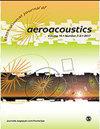Trailing edge serrations for noise control in axial-flow automotive cooling fans
IF 1.3
4区 工程技术
Q3 ACOUSTICS
引用次数: 0
Abstract
This study investigated the use of trailing edge serrations to reduce the noise generated by axial-flow automotive cooling fans. Three different serration profiles (sinusoidal, rectangular, and triangular) were examined, with the profiles being extended radially along the entire blade length and truncated at half the blade length while keeping the dimensionless wave number k ∗ and wave amplitude 2 h ∗ constant. The simulations employed a hybrid URANS-LES solver for the flow field and Ffowcs Williams-Hawkings analogy for the sound field, corresponding to the maximum volumetric flow rate and fan rotational speed. Acoustic pressure measurements were taken at multiple receivers upstream and downstream of the fan, and the overall sound pressure level was computed based on the results. Furthermore, the study also compared the aerodynamic performance of all serration types with the baseline fan, revealing that the baseline fan was relatively more efficient than their serrated counterparts. Despite the reduced efficiency, the trailing edge serrations offered significant noise reduction benefits of up to 10 dB, making them a promising solution for improving acoustic comfort in automotive cooling systems.轴流汽车冷却风扇噪声控制的后缘锯齿
本文研究了利用后缘锯齿来降低轴流汽车冷却风扇产生的噪声。在保持无因次波数k∗和波幅2 h∗不变的情况下,研究了三种不同的锯齿形轮廓(正弦、矩形和三角形),这些轮廓沿整个叶片长度径向延伸,并在叶片长度的一半处截断。流场模拟采用混合URANS-LES求解,声场模拟采用Ffowcs williams - hawkins类比,分别对应最大容积流量和风机转速。在风机上下游多个接收机处进行声压测量,并根据测量结果计算整体声压级。此外,该研究还将所有锯齿型风扇的空气动力学性能与基线风扇进行了比较,发现基线风扇相对于锯齿型风扇效率更高。尽管降低了效率,但后缘齿形提供了高达10 dB的显著降噪效果,使其成为改善汽车冷却系统声学舒适性的有希望的解决方案。
本文章由计算机程序翻译,如有差异,请以英文原文为准。
求助全文
约1分钟内获得全文
求助全文
来源期刊

International Journal of Aeroacoustics
ACOUSTICS-ENGINEERING, AEROSPACE
CiteScore
2.10
自引率
10.00%
发文量
38
审稿时长
>12 weeks
期刊介绍:
International Journal of Aeroacoustics is a peer-reviewed journal publishing developments in all areas of fundamental and applied aeroacoustics. Fundamental topics include advances in understanding aeroacoustics phenomena; applied topics include all aspects of civil and military aircraft, automobile and high speed train aeroacoustics, and the impact of acoustics on structures. As well as original contributions, state of the art reviews and surveys will be published.
Subtopics include, among others, jet mixing noise; screech tones; broadband shock associated noise and methods for suppression; the near-ground acoustic environment of Short Take-Off and Vertical Landing (STOVL) aircraft; weapons bay aeroacoustics, cavity acoustics, closed-loop feedback control of aeroacoustic phenomena; computational aeroacoustics including high fidelity numerical simulations, and analytical acoustics.
 求助内容:
求助内容: 应助结果提醒方式:
应助结果提醒方式:


